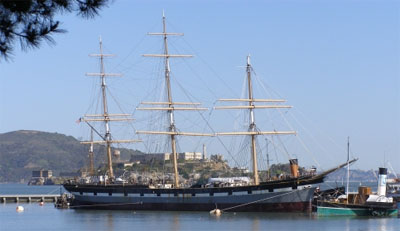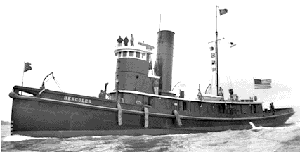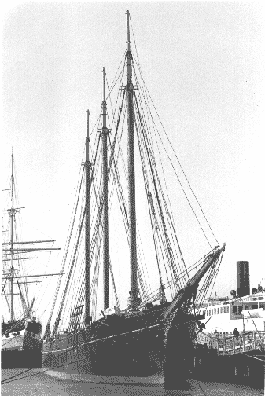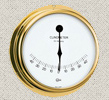Ships
° Clippers ° Steamships ° Shipping Lines ° Ship Builders ° Vessels and Rigging ° Shipwrecks
San Francisco Maritime National Historical Park
Alma
Scow schooners such as the Alma were essentially sail-powered cargo barges, carrying all sorts of bulk goods throughout the Bay and River Delta system. Built at Hunters Point in 1891, Alma is the last original sailing scow in existence. During the inid-1960s, she was restored to sailing condition and has since served as a roving ambassador of maritime history. Alma is maintained and operated largely by Park volunteers. After sailing out of Sausalito for some years, Alma resumed operations from Hyde Street Pier in the summer of 1992.
Balclutha

The earliest vessel in the Park collection, the Balclutha is probably the most striking of the fleet.
Balclutha is a three-masted, steel-hulled, square-rigged ship built to carry a variety of cargo all over the world. Launched in 1886 by the Charles Connell and Company shipyard near Glasgow, Scotland, the ship carried goods around Cape Horn (tip of South America) 17 times. It took a crew of about 26 men to handle the ship at sea with her complex rigging and 25 sails.
On January 15, 1887, with a twenty-six-man crew, Balclutha sailed under British registry from Cardiff, Wales, on her maiden voyage. She was bound for San Francisco. The ship entered the Golden Gate after 140 days at sea, unloaded her cargo of 2,650 tons of coal, and took on sacks of California wheat.
Because of the months-long ocean voyage, Balclutha made only one round-trip per year while engaged in the Europe-to-San Francisco grain trade. She arrived with a cargo three times, but also sailed in with pottery, cutlery, Scotch whisky (from Glasgow and Liverpool) and "Swansea general" (tinplate, coke and pig iron). Francisco.
During the mid-1890s the ship called at other ports around the world; in New Zealand, for example, she loaded wool and tallow for London, England.
In 1899 Balclutha was transferred to Hawaiian registry, and she joined the bustling Pacific Coast lumber trade. For three years the ship sailed north to Puget Sound, Washington, and then across to Australia. She was the last vessel to fly the flag of the Hawaiian Kingdom.
In 1901 a special act of the United States Congress admitted the ship to American registry so that she could engage in "coastwise" trade (i.e. between American ports). Soon thereafter, the Alaska Packers Association, a San Francisco firm which harvested and canned salmon, chartered her to carry men and supplies north to Alaska. When Balclutha went aground in 1904, the Alaska Packers Association purchased her where she lay for the non-princely sum of $500. After extensive repairs, they renamed her Star of Alaska. During this career, the ship sailed up the West Coast from Alameda, California, carrying supplies and cannery workers. In early September, her hold packed with cases of canned salmon, Star of Alaska started the 2,400-mile voyage back to San Francisco Bay. As Balclutha, the ship carried a crew of twenty-six men; on Star of Alaska, over 200 men made the trip north. Star of Alaska was the only sailing ship the Packers sent north in 1930, and when she returned that September she, too, was retired.
She has been restored in overall appearance to her British period, a time in which she called repeatedly at San Francisco, loading the grain cargos which formed the basis of the new state's agricultural exports.
Eppleton Hall
Among the Park's major vessels, the Eppleton Hall is an exotic.
Built in England in 1914, she spent her working life on the River Wear, near Newcastle, towing coal ships and barges. The major elements of Eppleton Hall's design - twin engines and side wheels, with a riveted plate hull - were fixed in the 1870s. The boat's single-cylinder engines are a variant of the side-lever type, used in ocean going steamers in the United States and England during the l840s and 1850s.
Although the Eppleton Hall has no direct connection with the West Coast, she is a vessel of unquestionable significance to the world's maritime history and is unquestionably worthy of preservation.
Eureka

Ferryboats are such familiar vessels that it is easy to underestimate the significance of the Eureka. She is, in fact, the largest floating wooden structure on earth. Her upper structure conceals a narrow and sleekly curved hull, designed for speed. Her massive single-cylinder walking-beam engine is the only one of its type left afloat. Eureka is the last of the traditional wooden hulled side-paddle ferries that served San Francisco.
Originally built as the Ukiah in 1890, she was rebuilt as Eureka in 1922, and served on the Sausalito-San Francisco commuter run until 1941. She could hold 2300 passengers and 120 automobiles.
Eureka's tall "walking beam" engine is the last working example of an engine-type once common on America's waterways. Manufactured by Fulton Iron Works of San Francisco, this engine remains unaltered to this day. Oil was burned in boilers to produce the steam, which drove a huge, vertical piston. Perched atop the engine, the walking beam changed this up-and-down motion into rotary motion via a connecting rod linked directly to the paddlewheel shaft. The twin paddlewheels (each twenty-seven feet in diameter) made twenty-four revolutions per minute.
In February of 1994, Eureka exited San Francisco Drydock after a $2.7 million restoration project. The steamship had been in the shipyard since October, where a crew of 45 skilled craftsmen caulked 2.5 miles of planking seams, and hammered in over 9000 eight-inch spikes. They applied stockholm tar, laid Irish Felt, and then plated the hull with 12,000 square feet of shining copper (cut down from modern dimensions to traditional-sized pieces to maintain the historical facade).
The vessel had suffered from rot in the edges of her main deck, and the caulking between her four-inch thick hull planks had softened. The immense beams holding up her paddle wheels and paddle boxes had deteriorated, and were replaced with steel. The overhanging ends and sides of the ferry were also repaired. To prevent the recurrence of rot, borate rods have been installed in all the new timbers.
In October of 1999, Eureka entered San Francisco Drydock for a $1 million restoration project focusing on the vessel’s superstructure -- the above-water portions of the vessel.
Hercules

Hercules is the only remaining deep water steam tug in the United States. Built in 1907 for the Red Stack Company of San Francisco, Hercules was designed for coastal towing work. She has been part of the Maritime Museum since l975, and in 1991 she steamed again under her own power, a tribute to the skills and dedication of Park volunteers, shipwrights and deckhands.
C.A. Thayer

The Golden Gate. Albert Bierstadt.

Built in 1895, the C. A. Thayer, named after C.A. Thayer, a partner is the E.K. Wood lubmer Co. of San Francisco, is one of 35 similar three-masted schooners built in the latter days of sail in the West Coast lumber trade. She was designed to run between Washington and California with heavy cargos of douglas fir. Thayer was large for a three-masted schooner but is otherwise typical of the period. Built entirely of Douglas fir, she has a single deck, an open hold, a very shallow draft and relatively wide beam. Her "bald-headed" rig, without separate topmasts, is representative of the later period of sail. Thayer speaks clearly of the hard and serious work of slipping lumber under sail along the unforgiving West Coast.
Wapama
Click on the Wapama's name for a link to information about her.












 Copyright ~ 1998-2018.
Copyright ~ 1998-2018. 